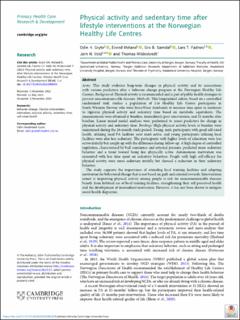| dc.contributor.author | Gryte, Odin Handeland | |
| dc.contributor.author | Meland, Eivind | |
| dc.contributor.author | Samdal, Gro Beate | |
| dc.contributor.author | Fadnes, Lars T. | |
| dc.contributor.author | Vold, Jørn Henrik | |
| dc.contributor.author | Mildestvedt, Thomas | |
| dc.date.accessioned | 2024-02-02T09:25:11Z | |
| dc.date.available | 2024-02-02T09:25:11Z | |
| dc.date.created | 2024-01-10T15:32:21Z | |
| dc.date.issued | 2024 | |
| dc.identifier.citation | Primary Health Care Research and Development. 2024, 25 (e4), 1-8 | en_US |
| dc.identifier.issn | 1463-4236 | |
| dc.identifier.uri | https://hdl.handle.net/11250/3115203 | |
| dc.description | This is an Open Access article, distributed under the terms of the Creative Commons Attribution licence (http://creativeco mmons.org/licenses/by/4.0/), which permits unrestricted re-use, distribution and reproduction, provided the original article is properly cited. | en_US |
| dc.description.abstract | Aims: This study evaluates long-term changes in physical activity and its associations with various predictors after a behavior change program at the Norwegian Healthy Life Centers.
Background: Physical activity is recommended and is part of public health strategies to prevent noncommunicable diseases.
Methods: This longitudinal cohort, based on a controlled randomized trial, studies a population of 116 Healthy Life Center participants in South-Western Norway who wore SenseWear Armbands to measure time spent in moderate to vigorous physical activity and sedentary time based on metabolic equivalents. The measurements were obtained at baseline, immediately post-intervention, and 24 months after baseline. Linear mixed model analyses were performed to assess predictors for change in physical activity and sedentary time.
Findings: High physical activity levels at baseline were maintained during the 24-month study period. Young, male participants with good self-rated health, utilizing local PA facilities were most active, and young participants utilizing local facilities were also less sedentary. The participants with higher levels of education were less active initially but caught up with the difference during follow-up. A high degree of controlled regulation, characterized by bad conscience and external pressure, predicted more sedentary behavior and a trend toward being less physically active. Autonomous motivation was associated with less time spent on sedentary behaviors. People with high self-efficacy for physical activity were more sedentary initially but showed a reduction in their sedentary behavior.
The study supports the importance of attending local training facilities and adopting motivation for behavioral change that is not based on guilt and external rewards. Interventions aimed at improving physical activity among people at risk for noncommunicable diseases benefit from habitual use of local training facilities, strengthening their self-perceived health and the development of internalized motivation. However, it has not been shown to mitigate social health disparities. | en_US |
| dc.language.iso | eng | en_US |
| dc.publisher | Cambridge University Press | en_US |
| dc.rights | Navngivelse 4.0 Internasjonal | * |
| dc.rights.uri | http://creativecommons.org/licenses/by/4.0/deed.no | * |
| dc.subject | self-rated health | en_US |
| dc.subject | sedentary time | en_US |
| dc.subject | physical activity | en_US |
| dc.subject | motivation | en_US |
| dc.subject | lifestyle intervention | en_US |
| dc.subject | behavior change | en_US |
| dc.title | Physical activity and sedentary time after lifestyle interventions at the Norwegian Healthy Life Centres | en_US |
| dc.type | Peer reviewed | en_US |
| dc.type | Journal article | en_US |
| dc.description.version | publishedVersion | en_US |
| dc.rights.holder | © The Author(s), 2024. Published by Cambridge University Press. | en_US |
| dc.source.pagenumber | 1-8 | en_US |
| dc.source.volume | 25 | en_US |
| dc.source.journal | Primary Health Care Research and Development | en_US |
| dc.source.issue | e4 | en_US |
| dc.identifier.doi | 10.1017/S1463423623000658 | |
| dc.identifier.cristin | 2224119 | |
| cristin.ispublished | true | |
| cristin.fulltext | original | |
| cristin.qualitycode | 1 | |

